|
| |
|
Lesson List:
Click on the title of a lesson to see it's overview. |
|
|
|
Title: Figure Drawing |
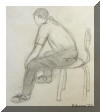
10 minute pose |
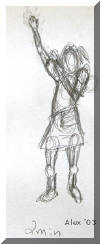 2
min. 2
min. |
| Grade Level: 8 |
|
Goals/Objectives (from Graded Course of Study): 22.e. FORM
26.a.
Demonstrates ability to produce Drawings
27.f.
Demonstrates ability to use standard techniques effectively for Pencil/pen and
ink
29.
Demonstrates ability to represent an object from various points of view |
|
Artistic/Occupational Influence: All artists use these techniques;
from commercial artists and to fine artists. |
|
Strategies (to meet needs of different learning styles): Each student will
have their own predispositions. If some students have trouble with a
clean final image, point them to a more expressive, looser style which will
fit their inclinations. |
|
Activities (Step by Step):
1. Pose two student
models within view of the drawing students.
2. Have
the students analyze how the models are positioned and find where the
modelsí joints and large features are located--head, shoulders, elbow, hips,
knees, feet, etc.
3. The
students will draw the joints and large body masses (torso, thighs, etc.) in
relation to each other and connect these with lines.
4. When
the students have drawn the structure sketches, they can draw the clothes
and flesh of their models.
5.
Emphasis should be given to LOOKING AT THE MODELS AND DRAWING WHAT IS REALLY
THERE INSTEAD OF WHAT THEY THINK SHOULD BE THERE.
TIME
Each
drawing should be timed and varying emphasis should be given to the overall
gesture, the structure, or to more detail. Drawing times can be
10
minute intro-structure and detail
5
minute structure
30 sec.-2
min. gesture only
These
drawings will be made over 3 or 4 class periods. |
|
Evaluation:
15% Was a good likeness
achieved?
20 % Does
this drawing reflect the proportions of the model?
15 % Use
of line and shading
50 %
Neatness/ Effort |
|
Follow-Up: These concepts will be revisited several times during the year in
various drawing assignments and painting projects. |
| Title: Classic
Face |
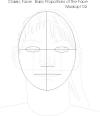 |
| Grade Level: 8 |
|
Goals/Objectives (from Graded Course of Study): Identifies
subject matter of art work: Portrait
25.d.
Proportion/Distortion
26.a.
Demonstrates ability to produce Drawings
|
|
Artistic/Occupational Influence: Portraiture |
|
Strategies (to meet needs of different learning styles): Students will be
encouraged to do their best and will be instructed that as long as it looks
human, it's o.k. |
|
Activities (Step by Step):
The instructor will draw an
example on the chalkboard step by step and the students will follow with
their own drawings step by step.
1. Have
students draw a large oval.
    2.
Dissect the oval with a horizontal and vertical line. 2.
Dissect the oval with a horizontal and vertical line.
3.
Divide the horizontal line into 5 equal spaces.

4. Divide the distance
from the horizontal line to the bottom of the oval in half.
 5.
Divide the distance from this line to the bottom of the oval in half. 5.
Divide the distance from this line to the bottom of the oval in half.
6.
Create ovals for eyes.
7.
Begin placing shapes in place for eyes, nose, mouth, and ears.
8.
Complete drawing and erase guide lines.
9. Add
hair and shade. |
|
Evaluation: As long as the proportions are reasonably close to the
basic proportions of the face, the grade will be good. |
|
Follow-Up: Student Portraits |
|
Title: Portraits |
Illustration:
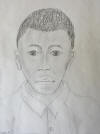 |
| Grade Level: 8 |
|
Goals/Objectives (from Graded Course of Study:
Identifies subject matter of art work: Portrait
25.d.
Proportion/Distortion
26.a.
Demonstrates ability to produce Drawings
|
|
Artistic/Occupational Influence: A fundamental subject matter: drawing the
human face. |
|
Strategies (to meet needs of different learning styles): Grades will
take into consideration individual capabilities. |
|
Activities (Step by Step): Students will be given a 12 x 18" of paper
and a pencil. They
will pair up and sit across from each other.
Each person will draw the
other simultaneously using techniques learned in the classic face exercise.
|
|
Evaluation: These are the essential guidlelines for grading:
C: If the drawing at
least looks like the classic face.
B: If the drawing has
more realistic "human" features.
A: If the drawing
looks like the person it was intended to look like. |
|
Follow-Up: Students will use several of these techniques in their out of
class drawing assignments during the year. |
|
Title: Plaster Project |
|
| Grade Level: 8 |
|
Goals/Objectives (from Graded Course of Study):
5. Explores the content or message of a work (include works depicting
everyday events, special events, observations)
8.
Identifies themes in art (ideas, events, or relationships important to
individuals and/or society, such as family, work, everyday life, historical
events, etc.)
11.
Discusses works of art in terms of artistís meaning and purpose, mood or
emotion, point of view
26.c.
Demonstrates ability to produce Sculptures
27.j.
Demonstrates ability to use standard techniques effectively for
Three-dimensional objects.
|
|
Artistic/Occupational Influence: George Segal, Representational Sculpture. |
|
Strategies (to meet needs of different learning styles): Independent
thinking and decision making is key here. Every project will be a
reflection of the student who made it. |
|
Activities (Step by Step):
Students will begin by
watching a video which outlines how to perform the basic plaster mold
technique.
The teacher will then
demonstrate more advanced techniques, how molds of arms and other body parts
will be made.
The students will then come
up with a concept for a 3-D sculpture which incorporates plaster molds of
their own body parts and elements of papier mache and other sculpture
techniques. Sculptures will be decorated and painted and will often
include various found objects.
Students will work in teams
to create plaster casts of their own bodies which will be incorporated into
their sculpture.
When all the plaster pieces
are created, the parts will be mounted into a cardboard box or other
support.
Papier mache will be used
to create other sculptural effects on the piece.
The piece, when finished,
will be painted or otherwise adorned.
Students will be encouraged
to add unconventional elements to their sculpture (feathers, yarn for hair,
lights, etc.)
VARIATION: The
plaster casts can be used as molds for ceramic projects by placing clay into
the reverse side of the masks.
|
|
Evaluation: Students will be graded as to the creativity of their
concept and the craftsmanship exhibited in the piece. |
|
Follow-Up: None |
|
Title: Impressionist Painting |
Illustration:

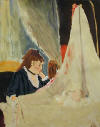 |
| Grade Level: 8 |
|
Goals/Objectives (from Graded Course of Study): II. Art
History and Culture 3. Identifies
subject matter of art work:
Portrait,
Landscape/Seascape, Still Life. 4. Discuss
the composition of a work of art (refer to elements of art and principles
of design, media, and techniques, Goal III) 16.
Recognizes works of art as historical artifacts and visual records of
civilization 18.
Identifies works of art from different periods of history, e.g., Greek,
Renaissance, Impressionist, etc. 22.c.
COLOR/COLOR SCHEMES: warm colors, cool colors, color wheel, primary colors,
secondary colors, tertiary colors, monochromatic, analogous colors,
complementary colors, tints, tones, and shades: intensity 26.b.
Demonstrates ability to produce Paintings 27.e.
Demonstrates ability to use standard techniques effectively for Paint |
|
Artistic/Occupational Influence: Various Impressionists |
| |
|
Activities (Step by Step): We will discuss the advent of Impressionism
with the rise of Monet and his cohorts in the mid 1800s with many examples
of their work shown. Students will then be given the chance to choose
an Impressionist master painting to work from. They will take this
drawing and draw it to the size of the canvas board we will be using, being
careful to get the composition correct. When this drawing is finished,
it will be transferred to the canvas board using charcoal covered paper.
The drawing will then be turned in. The student will then paint a copy
of the masterwork onto the canvas board using tempera paints. |
|
Evaluation: Composition, drawing, effective use of color and painting
techniques to reproduce an Impressionist style. |
| |
|
Title: Linoleum Block Prints |
Illustration: |
| Grade Level: 8 |
|
Goals/Objectives (from Graded Course of Study): |
|
Artistic/Occupational Influence: |
|
Strategies (to meet needs of different learning styles): |
|
Activities (Step by Step): |
|
Evaluation: |
|
Follow-Up: |
|
Title: Silkscreen Printing |
Illustration: |
| Grade Level: 8 |
|
Goals/Objectives (from Graded Course of Study): |
|
Artistic/Occupational Influence: |
|
Strategies (to meet needs of different learning styles): |
|
Activities (Step by Step): |
|
Evaluation: |
|
Follow-Up: |
|